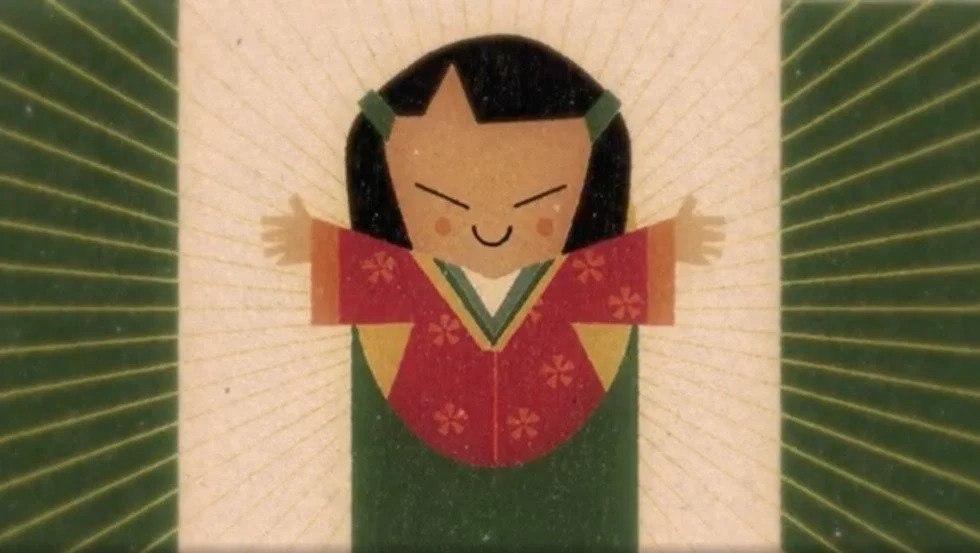
The Tale of Princess Kaguya (also referred to as The Tale of the Bamboo-Cutter) dates back to the Heian period (794-1185) and has been told, adapted, and reinvented numerous times since. While many variations exist, the core narrative remains the same as when it was written down as a monogatari (long-form prose narrative) by an unknown author over a millennium ago.
The tale begins with an old bamboo-cutter finding a baby inside a glowing bamboo stalk; as he and his wife are childless, he brings the baby home to raise as their own. As she quickly grows from an infant to a young woman, it becomes clear that she is no ordinary child, but a magical one who radiates light and brings luck to the family. Each time the bamboo-cutter returns to the grove, he finds gold or sumptuous textiles in the bamboo, and soon becomes rich. Her parents nickname her the “Shining Princess” (Kaguya-hime) for her glowing beauty, which soon attracts many ambitious suitors seeking to win her hand in marriage.
Kaguya has no interest in any of them, but offers impossible challenges to each of the five noblemen who are most insistent. Some fail, some cheat, one dies trying and the last gives up. Upon learning of Kaguya’s charms, the Emperor of Japan seeks her out for himself, but she rejects him as a suitor too. To the great concern of her parents, Kaguya has been spending her time gazing sadly at the moon. When they ask her what is troubling her, she finally reveals to them her true origins. She comes from the palace of the moon and must return there one day soon. The Emperor believes he can keep her on earth, so he deploys guards to surround her house on the day of her departure, but his forces are overwhelmed by the celestial beings who arrive to escort her back to the moon. Before she leaves, she writes moving letters of farewell to her family and to the Emperor. Her celestial entourage drapes a feather robe around her, erasing all her earthly memories as she ascends to the moon. The distraught Emperor writes her a letter which he burns at the top of the tallest mountain, a reference to the plume of smoke that would have still smoldered at the summit of Mount Fuji during the tale’s origins in the Heian period. Kaguya never returns, but her legend lives on.
With all its magic, mystery, and heartbreak, it is clear why Princess Kaguya is a tale that has not only survived through the centuries, but has also proven ripe for reinvention by new generations and in new media. It has been adapted in countless works of art ranging from 17th-century paintings to theater, cinema, manga, anime, and even video games. In 2013, the famed Studio Ghibli released their long-awaited version, The Tale of the Princess Kaguya, which was nominated for an Academy Award for best animated feature. Many have considered the story a form of early science fiction, with its theme of an “extraterrestrial” girl raised by a human family who must eventually return to her home on a different planet. Here on earth, Kaguya’s tale has become an integral part of Japanese culture, and it is associated so strongly with the moon that in 2007 when Japan’s space agency JAXA launched a lunar-orbiting space probe officially called “Selene”, the Japanese public lovingly nicknamed it “Kaguya”. To dive into this epic story and its emotional themes, watch the newest interpretation by Daniel Kondo, “Princess Kaguya and the Moon.”
Credit
“Princess Kaguya and the Moon” is a new animated short film produced by JAPAN HOUSE São Paulo in partnership with the acclaimed Brazilian children’s book illustrator Daniel Kondo, featuring narration and music by Carol Naine. Released in celebration of Brazil- Japan Space Week, the animation uses Kondo’s colorful signature style to retell one of Japan’s most beloved legends, riffing on both its ancient origins and connection to science fiction and dreams of space travel.
About Daniel Toyoiti Kondo
Daniel Toyoiti Kondo is a third-generation Japanese Brazilian illustrator and author of children’s literature. He has published more than 50 books in Portuguese, Spanish and other languages. Born in Passo Fundo (RS) in 1971 to a Japanese immigrant family, Daniel brings a cross-cultural perspective to his work. His grandparents were part of the wave of immigration to Brazil, marrying onboard the ship from Hokkaido Prefecture to Brazil. They worked as farmers planting corn, beans, coffee, and other subsistence crops in São Paulo State’s countryside and then later in Parana State.
In April 2020, Kondo produced the animated short film Princess Kaguya and the Moon for JAPAN HOUSE São Paulo to present during their Brazil-Japan Space Week programme. The film tells the story of Princess Kaguya and her relationship with the SELENE space probe. Currently, he is working on Kiki’s Delivery Service, a children’s illustration book written by Eiko Kadono and scheduled to be released in Brazil, as well as Monsters of Japan (Monstros do Japão), which reflects on the impact that yokai (monsters from traditional folklore) have had on the development of popular Japanese culture.
Describing the project, Kondo says: “Japanese culture has provided me a very particular way of feeling, understanding and interacting with the world. The masters of Ukiyo-e (woodblock printing) such as Hokusai and Hiroshige, are great influences and a strong inspiration in my work.”
About Jesse Paris Smith
Jesse Paris Smith is a writer, activist, musician, producer, and co-founder of Pathway to Paris. She has been composing, performing, recording, touring, and collaborating with other musicians and artists globally since 2004. Her main instrument is piano. She was born in Detroit, and spent her early childhood in St. Clair Shores, Michigan. She currently resides in NYC. She is 2021 Grammy-nominated and Clio Award Winner.

